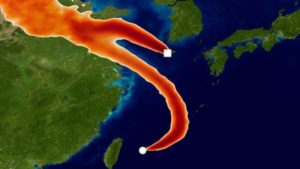China continues to use Banned Ozone-Depleting CFC: Study
According to a recent research published in journal Nature, China continues to use the banned ozone depleting chemical called CFC-11 in violation of Montreal Protocol.
Key Findings of Report
- Despite being a signatory to Montreal Protocol, and agreeing to phase out the production of harmful CFC-11 in 2010, China continues to emit ozone depleting CFC-11 in violation of Montreal Protocol.
- Suspicion: An initial study about a year ago reported new global emissions of CFC-11 gas, which many scientists, environmental groups and policymakers had suspected but were only able to locate source generally as East Asia.
- Confirmation: New findings by international team of researchers confirmed about suspected region and claimed that emissions of ozone layer harming gas are coming from eastern China, primarily from its two heavily industrialised provinces namely Shandong province and Hebei province. These two provinces originate between 40% and 60 % of total global CFC-11 emissions from Eastern China.
- Highlights: In years between 2008 and 2012, eastern China emitted an average of about 6,400 metric tonnes (MT) of CFC-11 per year, the emissions increased by 25% in 2012 and since 2013 CFC-11 emissions were on rise. This number then increased to an average of about 13,400 metric tonnes (MT) of CFC-11 per year in years between 2014 and 2017.
- Reasons: China has world’s largest polyurethane foam market which accounts for about 40 % of world’s total consumption. The Chinese foam manufacturers have been using CFC-11 illegally to save on higher cost of alternatives like hydrochloro-fluorocarbons named HCFC-141b, which is supposed to be phased out in China by 2026. The research also found evidence that factories in Shandong province were still making and using gas to manufacture foam insulation.
- Significance: The new research findings will add to international pressure on Chinese government to curtail the illegal use of CFC-11.
About CFC-11
- It is also called as freon-11, Trichlorofluoromethane or R-11.
- It is one of a class of compounds called chlorofluorocarbons that is responsible for destroying atmospheric ozone.
- It is also a potent greenhouse gases (GHG) that contributes to atmospheric warming.
- Before being included in production moratorium agreed in the Montreal Protocol of 1987 it was widely being used as a refrigerant.
About Montreal Protocol
- It is a legally binding international pact signed in 1987 to preserve degradation of atmospheric ozone layer that blocks harmful ultraviolet (UV) radiation from sun. Excessive amounts of some types of UV radiation can cause eye damage and skin cancer in people and are also harmful to crops and vegetation.
- The protocol prescribe that consumption and production of compounds that deplete ozone (03) such as halons, carbon tetrachloride, stratosphere-chlorofluorocarbons (CFCs), and methyl chloroform-are to be phased out by 2000 (2005 for methyl chloroform).
- According to World Meteorological Organization (WMO), hole in ozone layer is on path of recovery and reduction in atmospheric concentration of CFC-11 has made second-largest contribution to its decline since 1990s.
Month: Current Affairs - May, 2019


